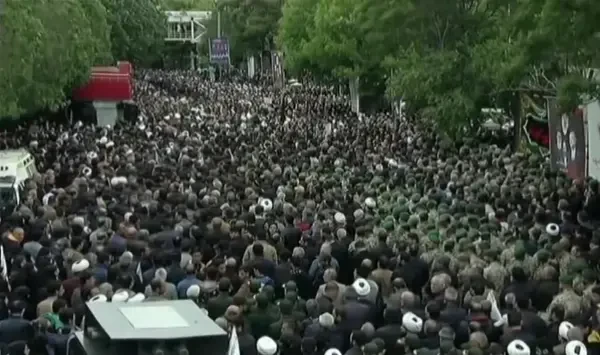Iran’s Plan to Strike Back Against the U.S.
Iran’s Military Preparations Following U.S. Attacks
Loading...

Iranians are observing the second of five days of public mourning declared by Supreme Leader Ayatollah Ali Khamenei.
Iranians gathered in Tabriz, the capital of East Azerbaijan province, to say goodbye to President Ibrahim Raisi, who died in a helicopter crash on Sunday.
Foreign Minister Hussein Amirabdullahian and six other people on the helicopter, including the crew, were also died in the crash.
Tens of thousands of mourners, waving Iranian flags and portraits of the dead president, left Sunday from the square in the western city of Lacey where Lacey had left the crash of his helicopter.
The funerals of Iranian government officials are being held "for a long time in some places." After the procession in Tabriz, the bodies of President, 63, and Amirab Abdullahian, 60, were moved to Tehran for another ceremony.
Earlier, and the body would be taken to Qom, a religious city in central Iran, for another ceremony on Sunday evening before being taken to the capital.
A larger meeting will be held in Tehran on Wednesday, and Supreme Leader Ayatollah Ali Khamenei is expected to lead prayers and foreign dignitaries.
President Ibrahim Raisi body was taken to Mashhad, the second largest city in the northeast of the country, where she was born and raised.
Organizers in Mashhad said they planned to hold an "honorable" funeral for President Ibrahim Raisi in the holy city on Thursday.
Ongoing Research
Speaking about the ongoing investigation into the cause of the crash, there is no indication at this time that it was a terrorist act, focusing on the weather conditions at the time, as well as challenging terrain and technical problems. perhaps.
Some people have questioned whether President Ibrahim Raisi and the other passengers were traveling on the Bell 212 twin-engine plane that is believed to be a decade old.
Foreign sanctions against Iran since its revolution in 1979 and subsequent sanctions over Iran's nuclear program and its support for the so-called "axis of deterrence" have made it difficult for the country to get new airplane parts and airplanes.
The public also asked why planes were allowed to fly in bad weather conditions such as thick fog.
BMM - MBA
Iran’s Military Preparations Following U.S. Attacks
Troops remain in five strategic locations, raising fears of renewed tensions and long-term occupation.
Opposition forces have taken control of the capital after a significant offensive. Here is how it unravelled.
